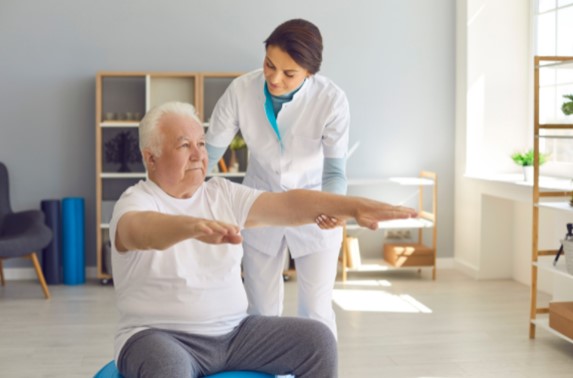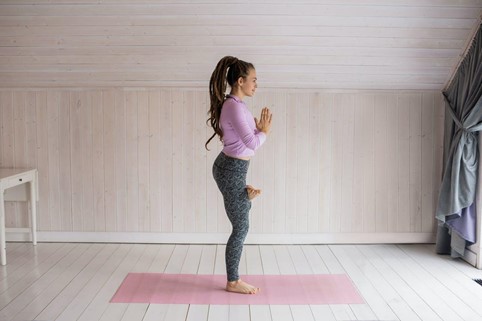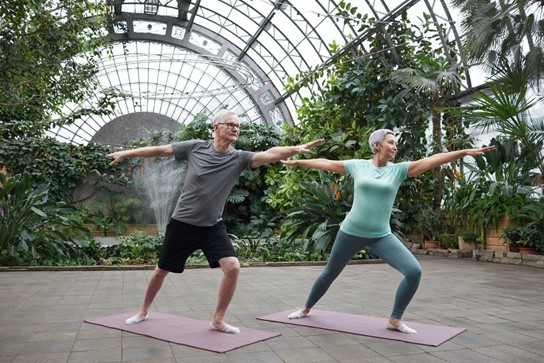Physical Therapy for Balance Problems: How to Improve Your Natural Balance?
Statistics show that 1 out of 3 Americans over 65 experience a fall every year. These incidents often lead to severe injuries and mobility issues. Physical therapy for balance problems can reduce the risk of fall injuries in older adults. Subsequently, assisting them in receiving effective rehabilitation and care to lessen the pain received from previous injuries.
Despite the increased interest in mindful movement and its importance, many Americans continue to struggle with balance issues. These problems occur due to restrictive work routines, non-ergonomic work settings, sedentary lifestyles, and declining health.
Specialized Physical Therapy strives to assist people who experience balance and gait issues through personalized physical therapy for balance and coordination. Physical Therapy for balance problems can be addressed through various exercises and treatments.
Before we discuss our treatment options, we would like to cover the basics of balance and coordination.
Let’s take a look.
Physical Therapy for Balance Problems: What Is Balance Control?
Balance control refers to the independent movement of the body.
A traumatic event, severe health issue, or degenerative disorder can cause an imbalance in this control. Consequently, these situations cause people to trip and fall easily. Balance issues can have a debilitative impact on the person’s life as they develop a fear of falling after a painful fall or due to their declining muscle strength.

Physical Therapy for balance issues can help improve the quality of life for you during these situations. It ensures that you regain strength and maintain an optimal level of activity. The failure to do so can lead to musculoskeletal disorders caused by prolonged sitting or lifestyle-based diseases (i.e. heart problems and obesity).
We discuss the main symptoms and causes of balance problems below.
The Signs: How Do You Feel When You Experience Balance Issues?
There are many different causes of balance issues, although most early symptoms of these disorders/mobility issues remain the same.
Most individuals with balance problems complain about:
- Dizziness or a spinning sensation (medically referred to as vertigo)
- Swaying, tripping, or stumbling when they walk or attempt to stand up after prolonged sitting
- Falling
- Fear of falling when you stand or move
- Muscle weakness
- Fatigue and lightheadedness can often lead to fainting spells
- Blurred vision
- Headaches/Migraines
- A constant need to hold onto a walking cane or someone/something for support when they walk
- Stiffness and swelling in the legs
Sometimes patients can maintain static balance without difficulty. That means they feel fine when they are standing or sitting in one position. These individuals experience difficulties when they move or have to respond physically to their surroundings. That means, for example, they may have difficulty in coordinating a response and catching a ball after it gets thrown their way.
Dynamic balance issues occur when signals sent from the eye or ear get altered during transmission. That’s why your body fails to respond correctly to changes in your environment. Additionally, it causes natural movements (i.e. walking, running, climbing stairs, etc.) to seem uncoordinated.
Causes of Balance Issues: Why Do You Experience Balance Issues?
The primary causes of balance problems include:
- Age-associated disorders (i.e. arthritis, neurological issues)
- Muscle weakness/fatigue
- Limited movement due to inactivity
- Joint stiffness and swelling
- Inner ear problems
- Traumatic injury (to the brain, spinal cord, or nerves)
- Stroke
- Cognitive issue
In all these scenarios, balance problems occur when one or more of our five body systems do not work correctly. For example, poor vision in old age can cause eye-tracking problems. These lead to stumbles and falls. Likewise, weak and damaged muscles are unable to support your body weight, causing you to sway and hurt yourself.
Other causes of dizziness include; fluctuating blood pressure (i.e. when your blood pressure drops suddenly) and irregular blood circulation caused by heart diseases can often make you lightheaded due to the inadequate oxygen supply. Due to this, you might fall and experience balance issues if you’re standing or walking. A drastic drop in sugar levels can be a cause for concern in some diabetics.
Besides this, inner ear problems (i.e. vestibular issues) are the most common cause of balance problems. They create physical instability and balance issues that are more challenging to control. Old age, an imbalanced diet, and health problems are all underlying factors of this problem.
Balance physical therapy aims to reduce risks by improving body mechanics, restoring muscular strength, and facilitating flexibility. These benefits have a positive impact on our bodies. In turn, this leads to better balance and gait.
How Do We Diagnose Balance Problems?
We request you to book an appointment with a physical therapist if you notice any signs of instability and/or a difference in your regular walking pattern.
Our physical therapists will assess your symptoms and perform a thorough evaluation of your medical history with current symptoms. The evaluation covers questions concerning how you feel and observational assessments.
We often request patients to perform a physical exam to test:
- Balance and gait (i.e. how you walk, move, and carry yourself)
- Joint flexibility and range of motion
- Indicators of visual stability
- Neck and arm strength/mobility
- Postural alignment
- Inner ear function
Apart from this, we consider proprioception (i.e. positional awareness in the upper and lower extremities), visual detection, muscle strength, and blood circulation, etc.
Initial diagnostic reports enable our team to identify the root cause of your balance issues. After this, we develop a personalized rehabilitation program. It includes balance exercises for the elderly, vestibular physical therapy, and other activities to improve your physical health and quality of life.
Balance Exercises Physical Therapy: Vestibular Physical Therapy & Balance Retraining Exercises

Vestibular physical therapy and goal-oriented balance retraining exercises are a vital part of our treatment plan. Our therapists develop individualized training programs to address balance issues and mobility problems.
These movement-focused treatment plans support patients by teaching different adaptation techniques. For instance, you might learn how to adapt to limited balance and maintain physical fitness through vestibular rehabilitation.
In turn, these tailored treatments reduce falls and limit further deterioration of your body mechanics. They also maintain good balance, gait, and functional mobility.
Here are some examples of physical therapy exercises for better balance:
Sit to Stand Exercise
One of the simplest balance exercises for the elderly requires individuals to sit and stand for a specific number of times. Not only does it increase your strength, but it improves stability.
Here’s how you perform this exercise:
- Position a chair in front of a table or countertop.
- Sit in a sturdy chair with ergonomic back support. Ensure that the chair does not have any wheels and doesn’t wobble.
- Place your feet firmly on the ground and position your buttocks forward, slightly towards the edge of your seat.
- Slowly lean your chest forward until it aligns with your toes. Then shift your weight as you rise to uphold a standing position.
- Sit down in a similar manner to maintain the initial position.
- Repeat this activity at least 7-10 times, depending on your stamina.
If required, you can use the table/counter in front of you to use as support when you stand.
The Single-Leg Standing Position
Practice stability and improve joint strength by standing on one leg for a designated period.
Here’s what you need to do:
- Use a table/chair as support.
- Hold onto your chosen support as you raise your right foot off the ground.
- Maintain this position for approximately 30 seconds.
- Gently place your right leg down.
- Repeat steps 2-4 with your left leg.
With time, you can make this exercise more complicated by standing on one leg without support. You may also increase the time duration in step 3. The other option is to close your eyes while you hold your position.
The Stability Walking Challenge
This dynamic balance exercise is often referred to as Tandem Walking. Patients need to walk at a certain pace and distance while their balance and gait get assessed.
In this case, you need to:
- Stand upright.
- Take one step and then place the other heel in front of your right toe.
- Continue heel-to-toe walking as you move 10-15 paces forward.
- Repeat action by moving backward to make this situation challenging.
Ensure that you have some type of support like a countertop, wall, or railing to hold onto if your knees give away when you move. Having some stability decreases the chances of injury.
Walking Challenge 2.0
This time around, you have to walk while turning your head left, right, and center. These movements will look like you are scanning your surroundings when you walk. Observe obstacles and remove them from the walking track you create for this challenge.
- This exercise requires you to:Move forward while you move your head up and down.
- Continue this as you walk 10-15 steps.
- Repeat movement by walking backward without bumping into anything and maintaining a straight line.
Apart from this, you can challenge your equilibrium by performing these exercises outside so that you learn how to navigate different obstacles.
What’s more?
Use other balance and gait techniques to assess your balance and stability.
- The BAPS board
- Spongy foam pieces or pillows
- Wobble board
- Exercise balls
Safety First
People experience balance and coordination issues are susceptible to falls more than others. That’s why you shouldn’t overexert yourself when you’re performing these exercises. Listen to your body and stop your activity if you experience extreme pain or discomfort during the exercise. The failure to do so can cause your muscles to become strained or your joints to give away, causing you to fall.
Our physical therapists do their best to assign activities and challenges that are age-appropriate and carefully adapted to align with specific healthcare conditions. This minimizes the risk of fall injuries during your exercise sessions.
The Balancing Act: More Safety Tips to Facilitate Physical Therapy for Balancing Problems

Balancing exercises for elderly and young adults vary depending on specific health issues and strength. For instance, most senior-friendly exercises require less stamina and technique than challenges created for their younger counterparts. Physical Therapy for Balance Problems can incorporate pilates, yoga, Tai-Chi, and other alternative low impact exercises to retrain balance disorders.
Nevertheless, the success of your physical therapy for balance will be incomplete if we ignore other aspects of your health. That’s why we encourage patients to make active and healthy lifestyle choices to support their treatment plans.
Here are a few things you may consider:
- Improve physical health by adopting an active lifestyle.
Try scheduling walks in the park or around your neighborhood. You can also pick up cycling and perform yoga once your balance issues improve to maintain an optimal level of weekly activity. The idea is to prevent falls by improving core muscles.
- Incorporate strength training and functional training with physical therapy for balance problems.
Our physical therapists will introduce you to strength training, multi-tasking, and postural retraining exercises if required. Research proves that a combination of balance control sessions will support your rehabilitation process by maximizing flexibility and restoring lost range of motion. Additionally, these exercises may alleviate pain and weakness often associated with balance issues.
- Eat a Balanced Diet
Weight and dietary choices can be linked with poor balance. We recommend patients prevent the risk of falling by modifying daily meal plans and maintaining a healthy weight. You can consult a nutritionist if there are severe concerns regarding your weight.
Furthermore, you might require a walking cane or hiking pole to support your movement (i.e. walking, standing, and climbing stairs). This step is advisable for patients dealing with serious injuries, post-operative mobility issues, or degenerative joint disorders, amongst other things.
Final Thoughts
In conclusion, physical therapy for balance problems can enhance your quality of life. It offers functional support and strength required to reduce the risk of falls and optimize movements. We strongly advise individuals to seek medical consultation as soon as they experience instability, unexplained weakness, or an increase in falls.
Early intervention can minimize balance and gait issues. Vestibular training, in particular, facilitates patients of all ages. Consistent practice leads to improved balance and better health. All this can be possible with the proper assistance and care.
Therefore, our personalized programs benefit individuals that require one-on-one assistance.
If you are interested in balance training exercises and vestibular physical therapy, give Specialized Physical Therapy a call @ 201-773-8851 or email us to start a rehabilitation program tailored to your needs.

